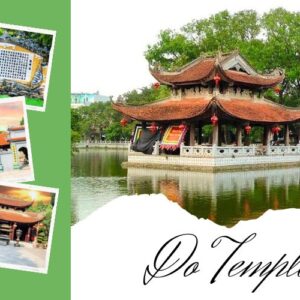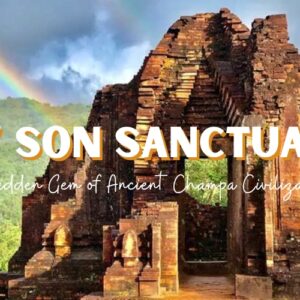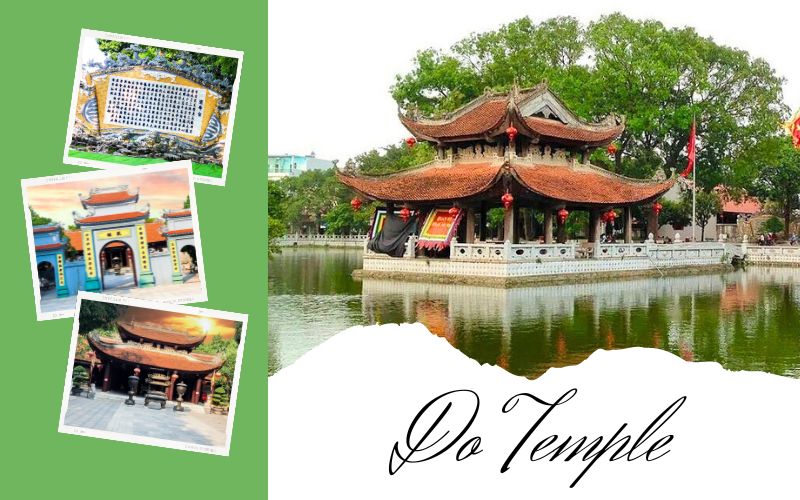
When discussing renowned attractions in Bac Ninh, it is essential to highlight Do Temple. This ancient temple, dating back almost 1000 years, is dedicated to the worship of King Ly Cong Uan. A visit to Do Temple offers more than just the opportunity to immerse oneself in the sacred ambiance of the temple and appreciate its unique architecture. Additionally, visitors can partake in the renowned Do Temple festival, which draws attendees from both nearby and distant locations. The festival provides an extraordinary cultural experience that shouldn’t be missed. For further information and in-depth insights, refer to the content below with IDC Travel.
Location of Do Temple
The construction of Do Temple, also referred to as Co Phap Dien or Ly Bat De Temple, is situated in the southeastern part of Co Phap incense, within the boundaries of Dinh Bang village, Tu Son, Bac Ninh. Legend has it that in bygone times, there existed the Bang forest and the Tieu Tuong River, flowing right in front of the temple gate. This unique location, characterized by the convergence of natural elements, including possibly eight dragon heads, was deemed highly suitable for future incense burning and spiritual reverence by the people.
Do Temple has a convenient location of approximately 20km from Hanoi, offering easy accessibility. There are three transportation options to reach Do Temple in Bac Ninh:
- Option 1: Begin from Chuong Duong Bridge, and follow the route: Chuong Duong Bridge – Nguyen Van Cu Street – Ha Huy Tap Street – Tran Phu Street (Tu Son). Upon reaching Tu Son, there will be a signpost indicating a right turn. Continue straight for a short distance, and you will arrive at Do Temple.
- Option 2: Depart from Vinh Tuy Bridge and proceed on Road 5 until you join National Highway 1A, heading south towards Phu Chan. Take a left turn in the direction indicated by the signboard, leading to Do Temple.
- Option 3: If you don’t have a personal vehicle, you can opt for the bus route to Co Phap Temple. Several bus options are available from Hanoi to Do Temple, such as routes 10, 54, and 203.
To facilitate your transportation to Do Temple in Bac Ninh, renting a car with a private driver is a convenient option. This choice enables you to swiftly reach your destination while also benefiting from the knowledge and insights shared by an experienced local driver. Not only will you enjoy a hassle-free journey, but you’ll also have the opportunity to gain valuable information about the history, culture, and people of Bac Ninh. Feel free to contact us for more information.
>>> Read our Bac Ninh travel guide here for more ways to get to Do Temple and its nearby tourist destinations.
The Temple’s History
Den Do (Do Temple) has its origins dating back to the Ly Dynasty in 1030. It was constructed southeast of Co Phap Village, known today as Dinh Bang Village, in Tu Son District. Notably, this was the birthplace of Ly Cong Uan, who later became Ly Thai To, the first emperor of the Ly Dynasty.
In 1010, after ascending to the throne, Ly Thai To embarked on a symbolic dragon boat journey along the serene Tieu Tuong River, returning to his hometown to pay respects to the elderly and honor his mother’s tomb with incense offerings. He designated a vast area spanning several miles as Son Lang Cam Dia, a forbidden mausoleum area, which encompassed the elaborate tombs of the Ly family. Following the passing of Ly Thai To in 1028, his son, Ly Thai Tong, ascended the throne and constructed the Do Temple within Son Lang Cam Dia to venerate his father. During one of his visits to his hometown of Dinh Bang to commemorate his father’s death anniversary, Ly Thai Tong took the initiative to establish Temple Do. He entrusted someone with the task of transforming the old communal house into a place of worship dedicated to his father and to serve as a welcoming site upon his return. Over time, this temple also became a sacred space for honoring the successive kings of the Ly Dynasty.
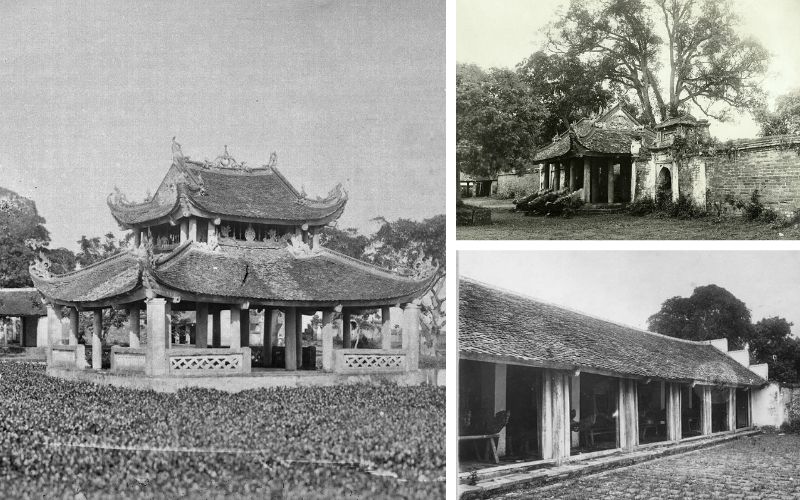
Some historical pictures of Do Temple
On March 3, 1030, the construction of the temple commenced, marking an important milestone in its history. The date holds significance as the beginning of the temple’s physical manifestation, solidifying its role as a revered place of worship and remembrance for the Ly family.
The temple underwent numerous repairs and expansions throughout its history, with the most significant enlargement occurring in 1602. At that time, the temple complex covered an expansive area of 31,250 square meters and featured 21 distinct buildings. Unfortunately, during the war against the French in 1952, the temple suffered extensive damage. However, in 1989, it was meticulously restored, meticulously preserving its original 17th-century architecture, thus reinstating its historical and cultural significance.
The Temple’s Unique Architecture
Do Temple’s architecture is the successor of royal and folk styles. These two architectural styles are harmoniously combined with nature to create an airy and beautiful space. Although the Do Temple relic complex is quite large, it is divided into separate zones that give visitors different feelings: the dignified harem, the majestic main hall, and the relaxed, civilized, and quiet state.
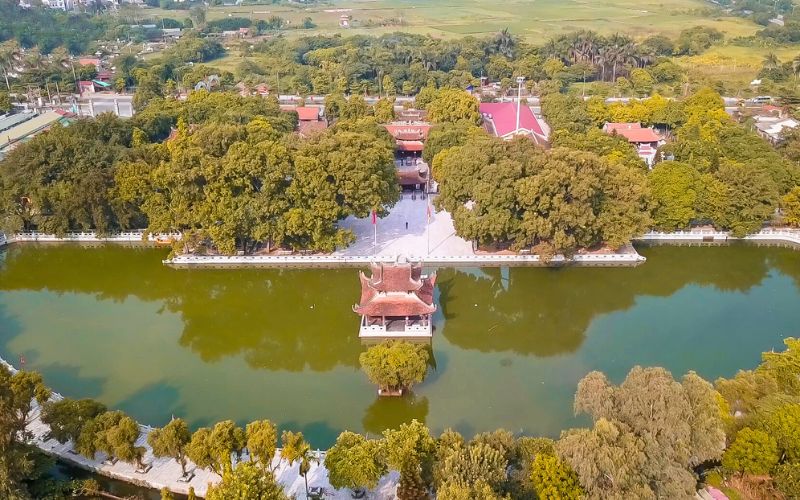
The space of Do Temple through an overhead view
Furthermore, the Do Temple stands out for its exceptional display of unique Vietnamese architectural artistry. The temple showcases various forms of artistic expression, including stone sculpture and wood carving, which contribute to its distinctive aesthetic appeal.
The stone sculptures found within the temple grounds feature intricately crafted depictions of revered animals such as elephants, dragons, unicorns, and horses. These sculptures not only showcase the skill and artistry of the craftsmen but also add to the symbolic and cultural significance of the temple. Wood carving art is also prominently displayed throughout the temple. Carved unicorns, decorative patterns, and dragons adorn the interior and exterior of the temple, showcasing the mastery of woodworkers in their intricate detailing and craftsmanship. Moreover, the art of sculpting worshiping statues, as well as the construction of the temple’s roofs and columns, exemplifies a high level of sophistication and beauty. These elements harmoniously combine to create an awe-inspiring visual spectacle for visitors, highlighting the rich artistic heritage of Vietnam.
>>> Explore Do Temple and the rural charms of Bac Ninh with our Bac Ninh Day Tour from Hanoi.
Inside the Temple
The urban area has a total area of 4,320 m2, designed in the style of “Foreign interior and exterior”. This area includes Ngu Long Mon, the main hall, the transfer house, and the stele house. Ngu Long Mon is the entrance gate of the inner city, so named because on both gates are carved images of five dragons very delicately. The center of the inner hall is the main hall. In the main hall, there is Phuong Dinh, also known as the square house, Tien Te house.
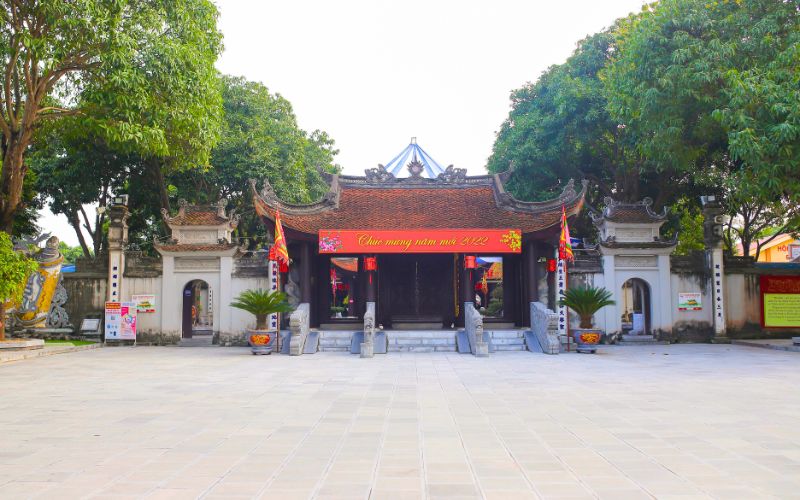
Ngu Long Mon Gate – Main door of the Temple
Phuong Dinh is 70 m2 wide, built 3 compartments, and 8 roofs. Tien Te House has 7 rooms of 220 m2, d is the place to worship King Ly Thai To. On the left side of the main hall hangs the sign “Chieu Doi Do” of King Ly Thai To with exactly 214 words, corresponding to 214 years of the reign of the 8 kings of the Ly Dynasty. On the right is a signboard with the poem “Nam Quoc Son Ha Nam De Cu”. In the middle of the altar, there is a statue of two people wearing black robes, soldiers of the Ly Dynasty, carved very vividly. The two sides near the door have a pair of white and pink horses made of jackfruit wood, with enough saddles, armor, copper bridles, and rattles.
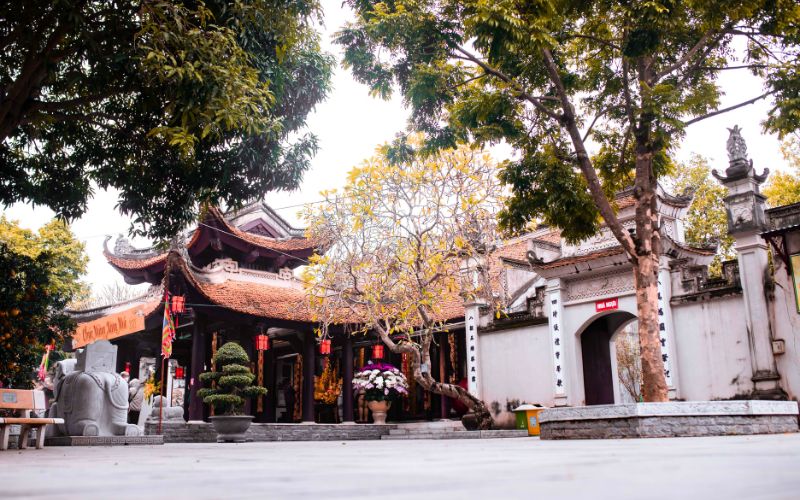
The main hall of Do Temple worships King Ly Thai To
The old French-style mansion has 7 compartments, 180 m2 wide. This is where the throne, tablets, and 8 kings of the Ly Dynasty were located. The middle compartment worships King Ly Cong Uan and Ly Thai Tong, the left three compartments worship Ly Nhan Tong, Ly Hue Tong, and Ly Anh Tong, and the right three compartments worship Ly Thanh Tong, Ly Cao Tong, and Ly Than Tong.
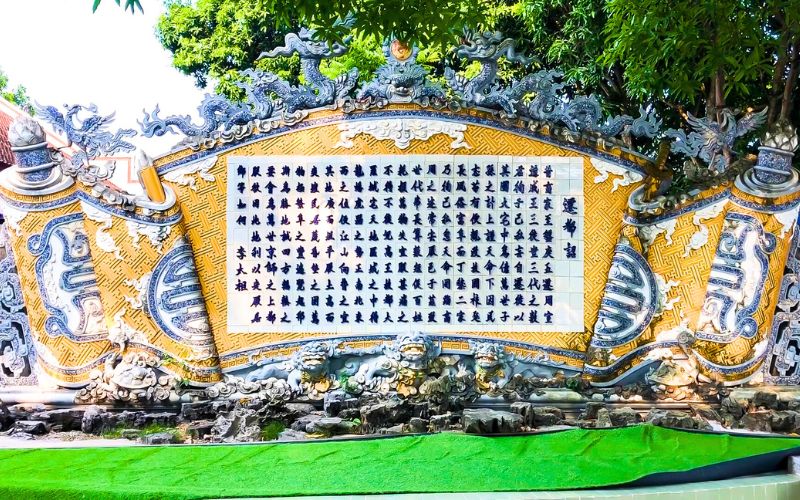
“Chieu Doi Do” is made of Bat Trang ceramics
In particular, Do Temple also owns the largest Bat Trang ceramic calligraphy book in Vietnam. This book is located in the right compartment, more than 8m wide, 3.5m high, and embossed with Chinese characters, all letters are glazed with Bat Trang green with an area of about 6m2. This set of characters was created by a group of Han Nom class in Huong Nam, Hanoi, the handwriting was attached by Mr. Pham Xuan Hoa’s family.
Outside the Temple
The suburban area surrounding Do Temple comprises several notable structures, including Thuy Dinh, Van Chi, Vo Ca, Sacrifice House, Guest House, Warehouse, and King Ba Temple.
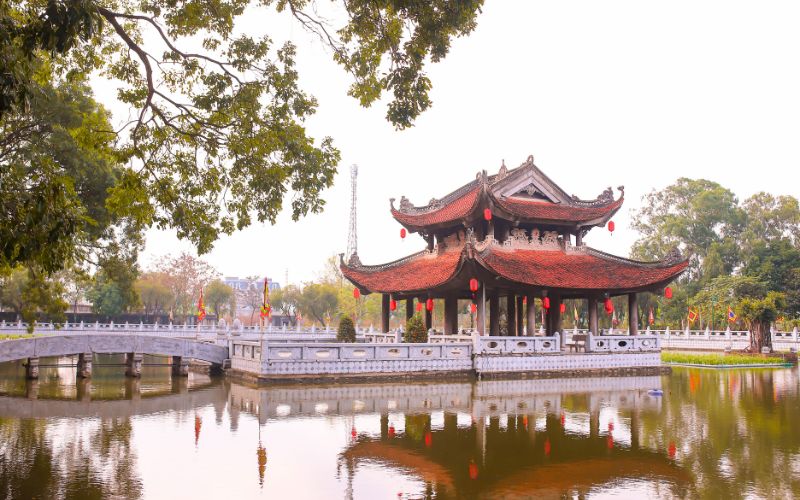
Thuy Dinh
Thuy Dinh, situated on the surface of a semicircular lake, features a distinctive architectural design. It spans 5 compartments in width, with 8 roofs and 8 curved blades. This area served as a venue where esteemed officials of the past would gather to witness water puppet shows, an ancient Vietnamese art form. The semicircular lake is connected to the Upper Ca Pond, lower Ca Pond, and the historic Tieu Tuong River. Notably, during the French colonial period, this temple was chosen to be depicted on the five-inch banknotes by the Indochina Bank.
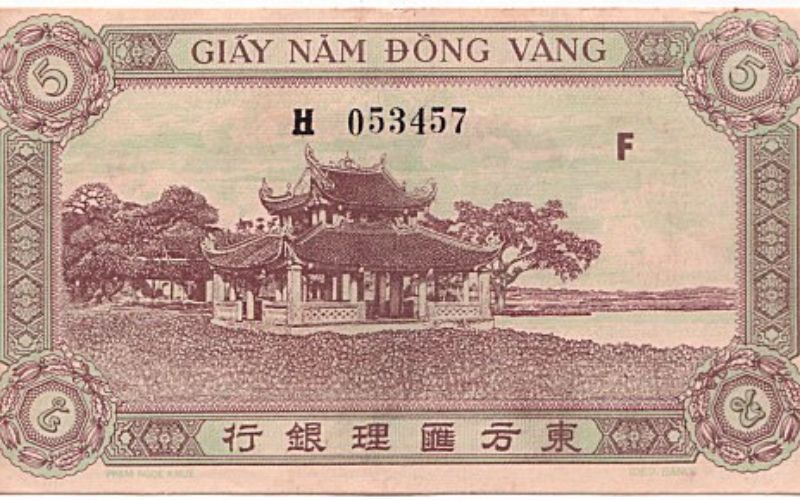
Thuy Dinh in the old paper money
Van Chi, positioned to the left of the inner city, consists of 3 compartments and spans 100 meters in width. Its architectural style resembles a stack of matches. Van Chi is dedicated to the worship of esteemed officials who made significant contributions to the Ly Dynasty, such as To Hien Thanh and Ly Dao Thanh. On the right side of the inner city stands Vo Ca, which shares a similar architectural style with Van Chi. It serves as a place of worship for martial arts officials who rendered meritorious services to the Ly Dynasty. Notable figures honored here include Ly Thuong Kiet, Le Phung Hieu, and Dao Cam Moc.
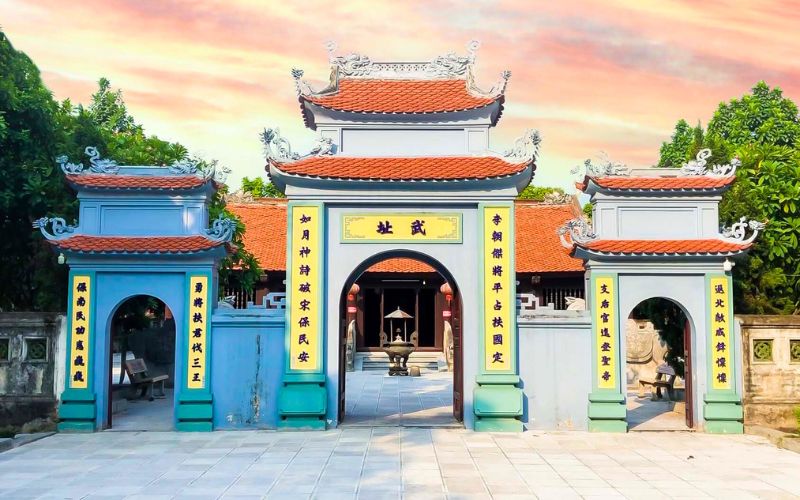
Vo Ca – The place of worshiping mandarins and martial arts of the Ly dynasty
These structures within the suburban area surrounding Do Temple add to its cultural and historical significance, each with its unique purpose and architectural charm. Visitors can explore and appreciate the diverse facets of Vietnamese history and heritage that these buildings represent.
Do Temple Festival
The Do Temple hosts an annual festival known as the Do Temple Festival, held on the 15th day of the third lunar month. This date corresponds to an important historical event, as it marks the ascension of Ly Cong Uan to the throne in 1009, becoming the king of Dai Co Viet, the former name of Vietnam. The festival’s ceremonial proceedings commence with a grand procession of the tablet of King Ly Thai To, the founder of the Ly Dynasty, to Ung Tam Pagoda, which holds significance as the birthplace of Ly Thai To. This procession serves as a symbolic tribute to the esteemed king.

Do Temple Festival
The Do Temple Festival features a vibrant array of cultural activities and traditional performances. Visitors can enjoy the melodic tunes of Quan Ho folk performances, which is recognized as a World Intangible Cultural Heritage by UNESCO. Water puppet shows, a unique and enchanting art form, are also performed during the festival, captivating the audience with their intricate puppetry and storytelling. In addition, various competitions are organized as part of the festivities. These include wrestling matches, chess competitions, cockfighting, and pigeon releasing, providing entertainment and excitement for participants and spectators alike.
The Do Temple Festival is a cherished event that pays homage to the Ly Kings and celebrates the rich cultural heritage of Vietnam. It offers visitors an opportunity to immerse themselves in the traditions, rituals, and festivities that have been passed down through generations.
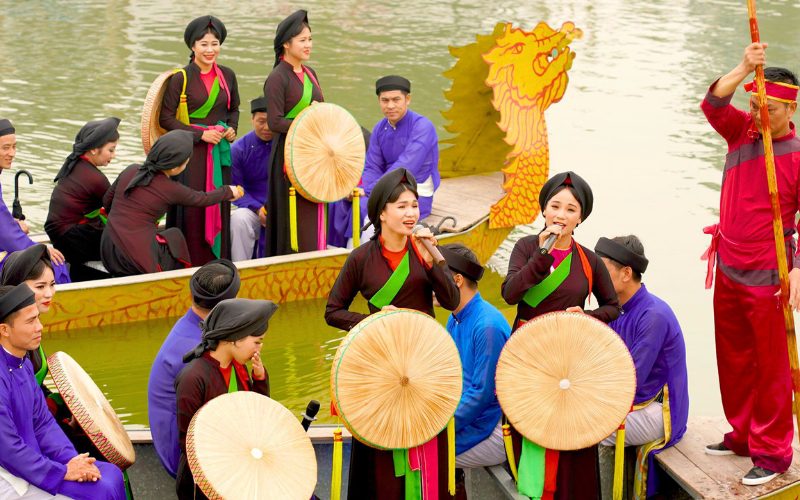
Quan Ho Bac Ninh
Do Temple is a destination that is highly valued for its cultural preservation and artistic significance. Upon visiting this remarkable place, you will find yourself immersed in the enchanting atmosphere of an ancient dynasty, allowing you to truly experience the rich culture and historical heritage of the flourishing era. While exploring Do Temple, it is customary to light incense sticks as a symbol of gratitude and to offer prayers for good fortune, peace, and happiness. Don’t hesitate to contact us for more details about this unique and spiritual experience!
